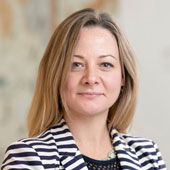Biography
Dr Alanna Hare graduated in 1999 at Selwyn College, University of Cambridge and completed her postgraduate training at Imperial College School of Medicine in 2002. She trained in cognitive behavioural therapy for insomnia (CBTi) at the University of Oxford.
She trained in respiratory and general medicine in London at St Mary’s Hospital, St Thomas’ Hospital and the Royal Free Hospital.
She completed her masters in clinical education in 2013 and was awarded distinction for her work on the assessment of clinical competence. She has also completed a postgraduate certificate in medical leadership and management through the Kings Fund and Manchester Business School as part of the prestigious Darzi Fellowship programme.
Dr Hare is President of the British Sleep Society and Treasurer of the British Thoracic Society, sitting on their Board. She has authored the National Sleep Outpatient Pathway on behalf of NHS England and Getting It Right First Time (GIRFT).
Areas of expertise
Dr Hare sees adult patients with respiratory disease and is a specialist in lung failure and the use of non-invasive ventilation (NIV). She also has a specialist interest in sleep disorders, including:
- sleep apnoea
- restless legs syndrome
- periodic limb movement disorder
- insomnia
- parasomnias.
She has developed a simulator-based training programme in NIV for clinicians, for which she was awarded a European Respiratory Society education grant.
Dr Hare has spoken nationally and internationally on sleep medicine and the importance of training the multidisciplinary team in NIV, and has written a number of book chapters and articles on education and training in NIV. Her work has featured in the Independent, the Guardian, Vogue, Grazia, the Robb Report and Stylist, amongst others.
Research publications
Dr Hare's research publications can be found on PubMed.
Private patient referral
If you would like to make an appointment with this specialist for private care, contact the RB&HH Specialist care team.

